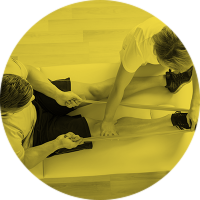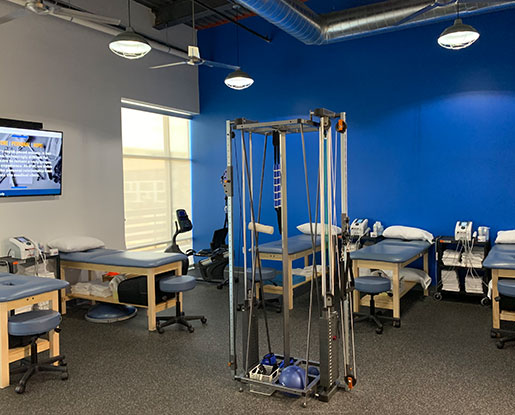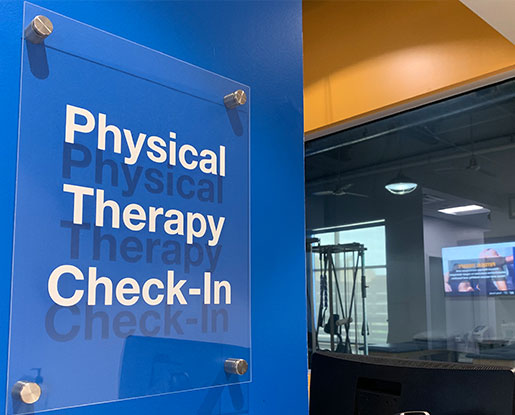Why Physical Therapy?
WHAT IS PHYSICAL THERAPY?
Physical therapy is the focus on movement in the treatment of people of all ages and abilities, helping them improve and maintain function and quality of life. Physical therapists create individual treatment plans to match each person’s goals, helping them improve their fitness and function, avoid surgery, reduce the use of opioids and other drugs, and partner in their own care.

Ready to Try Physical Therapy?
Schedule an appointment today.
Schedule an appointment today.
BENEFITS OF PHYSICAL THERAPY
Maximize Your Movement
Pain-free movement is crucial to your quality of life, your ability to earn a living, and your independence. Physical therapists are movement experts who can identify, diagnose, and treat movement problems.
Participate in Your Recovery
Physical therapists work collaboratively with their patients and clients. Treatment plans are designed for each person’s individual goals, challenges, and needs.
Avoid Opioids
Opioid risks include depression, overdose, and addiction, plus withdrawal symptoms when stopping use. In some situations, dosed appropriately, prescription opioids are an appropriate part of medical treatment. However, the Centers for Disease Control and Prevention (CDC) is urging health care providers to reduce the use of opioids in favor of safe alternatives like physical therapy for most long-term pain.
Avoid Surgery
Before you undergo expensive or invasive surgery, try physical therapy. For some conditions, including meniscal tears and knee osteoarthritis, rotator cuff tears, spinal stenosis, and degenerative disk disease, treatment by a physical therapist has been found to be as effective as surgery.
Physical therapy can be an effective treatment for a wide variety of injuries and conditions. If you are experiencing pain or your ability to move freely has been diminished, there is a good chance physical therapy may be a good option for you. Some of the conditions we frequently treat with physical therapy include:
Achilles Tendon Injuries (Tendinopathy)
AC Joint Injuries
Ankle Fractures
Ankle Impingement
Ankle Sprains/Strains
Ankylosing Spondylitis
Anterior Cruciate Ligament (ACL) Tears and Post-op Rehabilitation
Balance Problems
Benign Paroxysmal Positional Vertigo (BPPV)
Biceps Tendinitis
Biceps Tendon Rupture
Bunion (Hallux Valgus)
Calf Strain
Carpal Tunnel Syndrome
Cervical Radiculopathy
Cervical Sprains/Strains
Cervical Whiplash
Chronic Pain Syndromes
Complex Regional Pain Syndrome (CRPS)
Cubital Tunnel Syndrome
De Quervain’s Tendinitis
Degenerative Disk Disease
Degenerative Joint Disease
Elbow Bursitis
Fractures
Fall Prevention
Fibromyalgia
Frozen Shoulder (Adhesive Capsulitis)
Gait Dysfunctions
Greater Trochanteric Bursitis
Hamstring Injuries
Headaches
Herniated Disks
Hip Bursitis
Hip Impingement
Hip Labral Tears
Iliotibial Band (IT Band) Syndrome
Knee Pain
Knee Bursitis
Knee Sprains/Strains
Low Back Pain
Stress Fractures
Medial and Lateral Epicondylitis
Meniscus Tears
Shoulder Instability
Osgood-Schlatter Disease
Severs Disease
Osteoarthritis
Osteoporosis
Patellofemoral Pain
Patellar Instability
Peroneal Tendinitis
Plantar Fasciitis
Plica Syndrome
Rheumatoid Arthritis
Rotator Cuff Tear
Rotator Cuff Tendinitis
Sacroiliac (SI) Joint Dysfunction
Scoliosis
Shin Splints (Medial Tibial Stress Syndrome)
Shoulder Dislocation/Subluxation
Shoulder Impingement
Shoulder Labral Tear
Spinal Stenosis
Spondylolysis
Spondylosis
Spondylolysthesis
Thoracic Outlet Syndrome
Total Hip Replacements
Total Knee Replacements
Total Shoulder Replacements
Ulnar Collateral Ligament Injuries
Wrist Fractures
Wrist Tendinitis
At this time, physical therapy services are cash-pay only.







